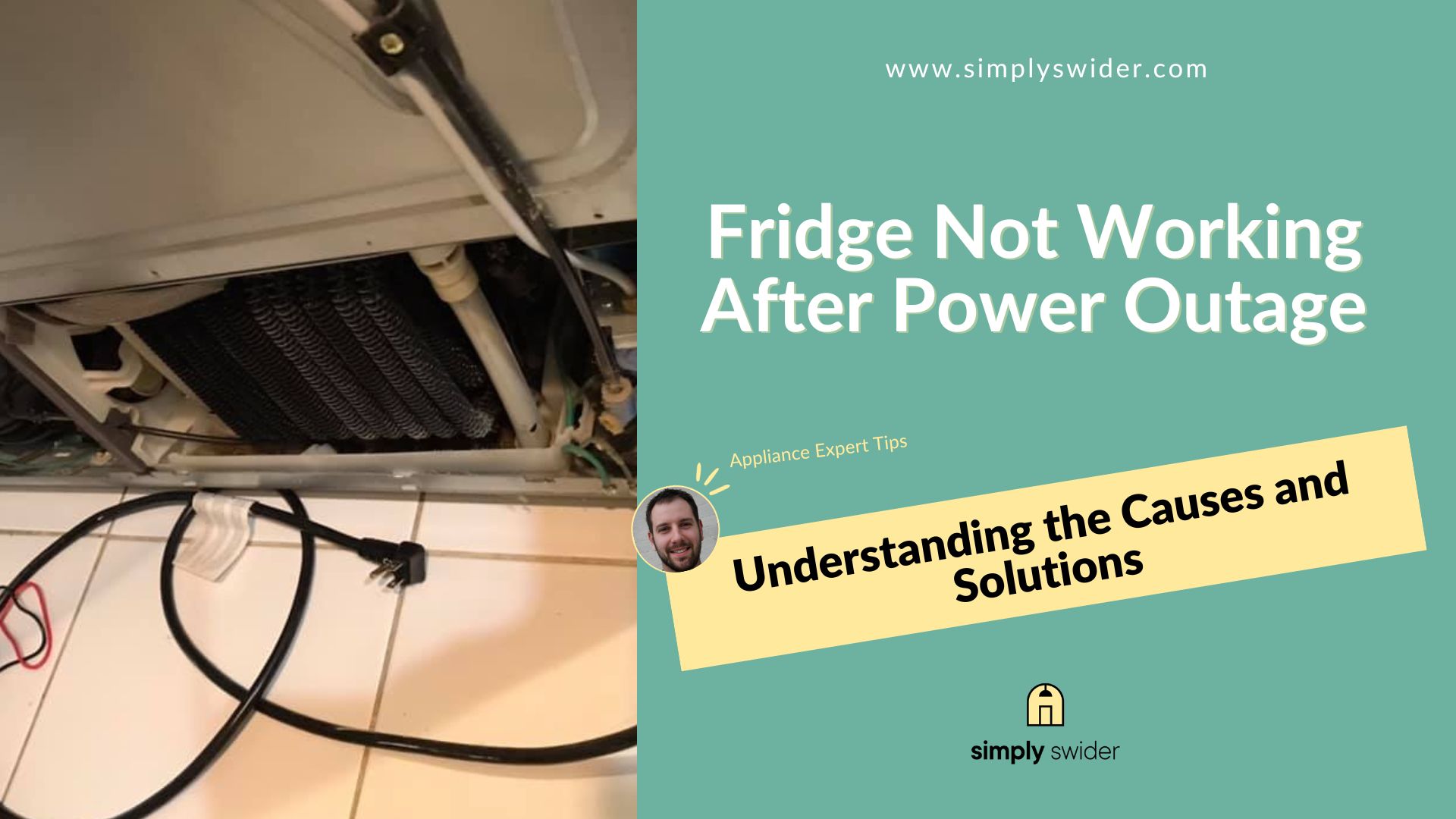Listen up, folks:
If there’s one call I dread as an appliance technician, it’s “My fridge isn’t working after a power outage.”
Why? Because a fridge is more than an appliance – it’s a vault for your food, your family’s health. When it fails after a blackout, the stakes are high.
That said, this issue isn’t just frustrating, it’s often preventable. Manufacturers should be doing more to build surge-resistant features, but until that happens, we’ve got your back.
For this critical topic, I’ve collaborated with David Park, a top-tier repair technician from Savannah, Georgia. Together, we’re going to dissect this issue and give you the solutions you need.
Ready to restore that fridge and save your groceries? Let’s dive in.
Table of Contents
Why Is My Refrigerator Not Working After a Power Outage?
If your fridge isn’t powering up after a blackout, a power surge likely zapped an essential component. In my experience, the usual suspects include the control board, inverter board, compressor start relay, or the compressor itself. Occasionally, your fridge might just need a gentle nudge—a simple restart or reset—to get it humming again.
In the following sections, David and I will walk you through the nitty-gritty of troubleshooting a fridge that isn’t starting or cooling after a power outage.
Then, we’ll walk you through the fixes, giving you the power to take charge.
Did you catch that electric pun?
Now:
But first, a quick detour – let’s discuss why fridges fail to start or cool after a power outage.
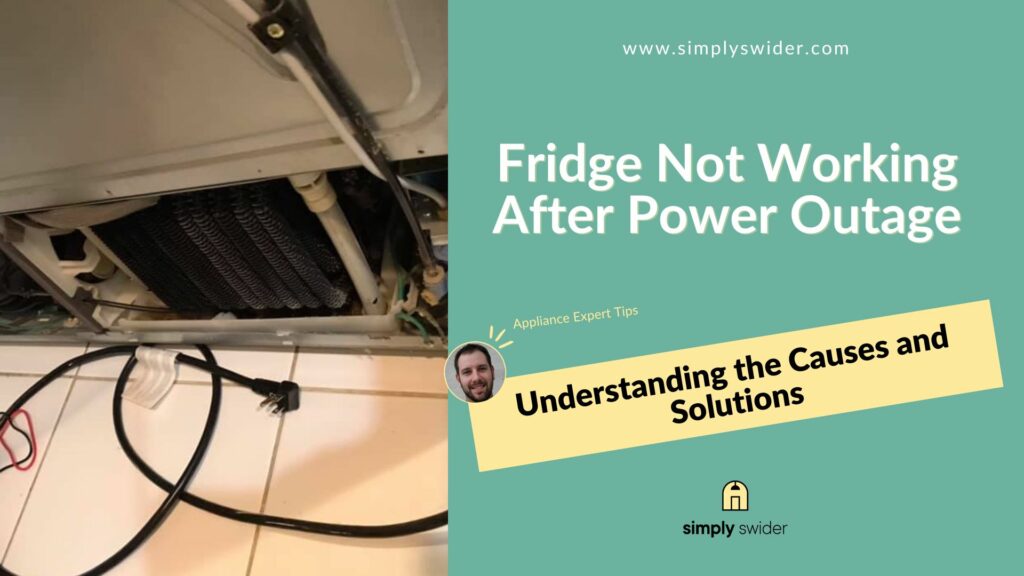
Why Does a Power Outage Damage Appliances Such as Fridges?
Ever wonder why your fridge seems off after a power outage? It’s not the blackout that’s the problem—it’s the moment the power comes back on.
The symptoms:
Let me break it down. If your fridge has been hit by a power surge, you might notice:
- It won’t start.
- Display or lights are out.
- Freezer or fridge isn’t cooling.
- Compressor’s silent.
- Odd clicking sounds.
- Ice maker or water dispenser fails.
- An error code pops up.
The science behind it:
Here’s the thing: Standard U.S. household outlets supply about 120 volts. Your fridge is designed to work smoothly at this voltage. But when the power comes back, the voltage can spike—sometimes reaching 200 volts or more.
The risk:
I’ve been called in more than once to replace control boards fried by these surges. These components aren’t designed to handle anything much beyond 120 volts. Expose them to a higher voltage, and you’re asking for trouble.
Some newer fridges have built-in delays to prevent them from turning on immediately after a power outage, reducing the risk. But let’s be honest, not every fridge has this feature.
So the next time there’s a power outage, consider unplugging your fridge before the electricity comes back on. It could save you a service call and a lot of headaches.
5 Reasons Why Your Fridge Is Not Working After a Power Outage
| Commonly Affected Part | Estimated Replacement Cost |
|---|---|
| Control board | $100-$500 |
| Compressor | $150-$700 |
| Compressor start relay | $20-$100 |
| Inverter board | $100-$600 |
1. Check Power
If the blackout is over but your fridge seems to be holding a silent protest, your first order of business is to inspect if it’s getting power.
As David rightly puts it, “Sometimes the fridge may not be getting power.”
Here’s how:
- Check whether the fridge’s circuit breaker has tripped.
- Try plugging a different appliance into the same outlet. If it powers up, you’re in the clear on that front.
- Carefully inspect the fridge’s plug and cable to make sure they’re not damaged.
Note:
“If the fridge’s interior lights, the digital display, and fans are functioning, then the unit is getting power,” David explains.
2. Main Control Board/Motherboard/PCB
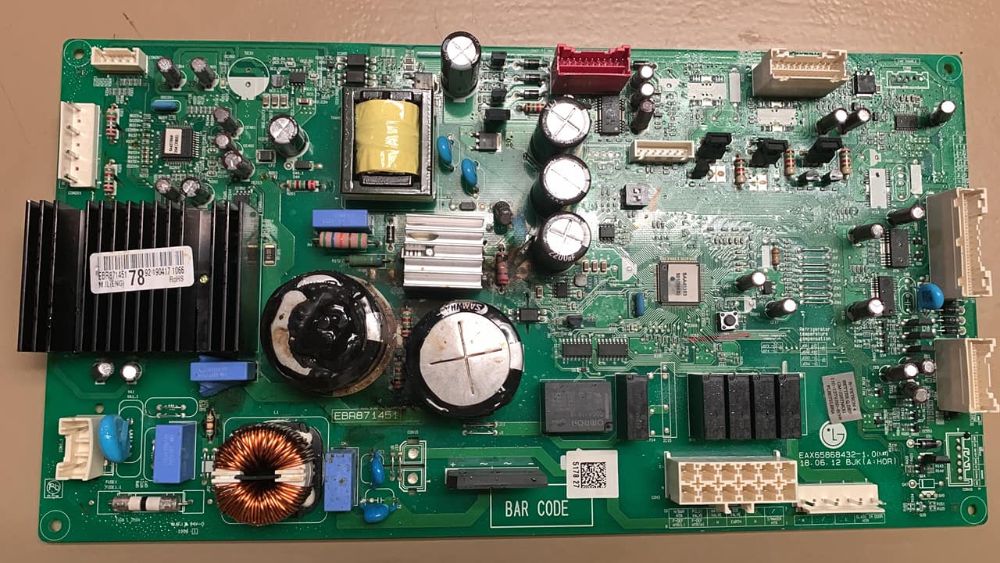
| Part | Main control board |
| Location | a) On the back of the fridge, behind a cover. b) Inside the unit, somewhere at the top. c) Inside the control panel d) Underneath the fridge, behind a toe kick panel. |
| Ease of troubleshooting | Burn marks and exploded components are easy to spot. Testing with a multimeter is complicated |
| Replacement cost | $100-$500 depending on the make and model. Refurbished or used boards are cheaper. |
| Repairable | Some damages are repairable, while others are not. |
| Note: | A fridge may have more than one control board. |
Problem:
Now:
Also known as the motherboard or printed circuit board (PCB), the control board is undeniably one of the key parts of a refrigerator.
As David explains: “Think of the control board as the refrigerator’s brain, coordinating and controlling every function and component.”
Now:
While the control board is the most sophisticated component, it’s notably vulnerable to damage, especially from power surges.
Why?
Control boards are packed with intricate electronic components, such as microprocessors, capacitors, and resistors.
“When a power surge occurs, it delivers an electrical charge that’s beyond what these components can handle, causing damage,” David expounds.
Identification:
Now:
If the control board is faulty, some or all of the functions it controls won’t work.
For instance,
- The fridge might not start.
- The lights could behave erratically.
- The compressor might remain silent.
- You might hear a clicking noise from the board.
- Other unusual noises
For instance:
This Redditor’s LG LBN22517ST fridge developed most of these symptoms after a power outage, and the cause ended up being a faulty main board.
Wondering if your control board took a hit during the outage?
The first step is to locate it for a thorough inspection and testing.
Where do you find it?
For the majority of refrigerator models, such as the GE GSH25JSTA SS fridge, you’ll find the control board at the back, behind a cover plate.
However, for some models, like this Frigidaire refrigerator, it’s located at the bottom behind a toe plate.
In other models like this Whirlpool refrigerator, the motherboard is located inside, right at the top after opening the door.
Now:
To zero in on your fridge’s control board location, refer to its tech sheet—often hidden at the bottom.
Once you have located the control board:
“Look for any obvious signs of damage, such as burns, char marks, or a swollen component. These are signs indicating potential damage,” David advises.
“Also, check on the underside if there is a faulty solder joint. Finally, shake the board and listen for any rattling noise,” David adds.
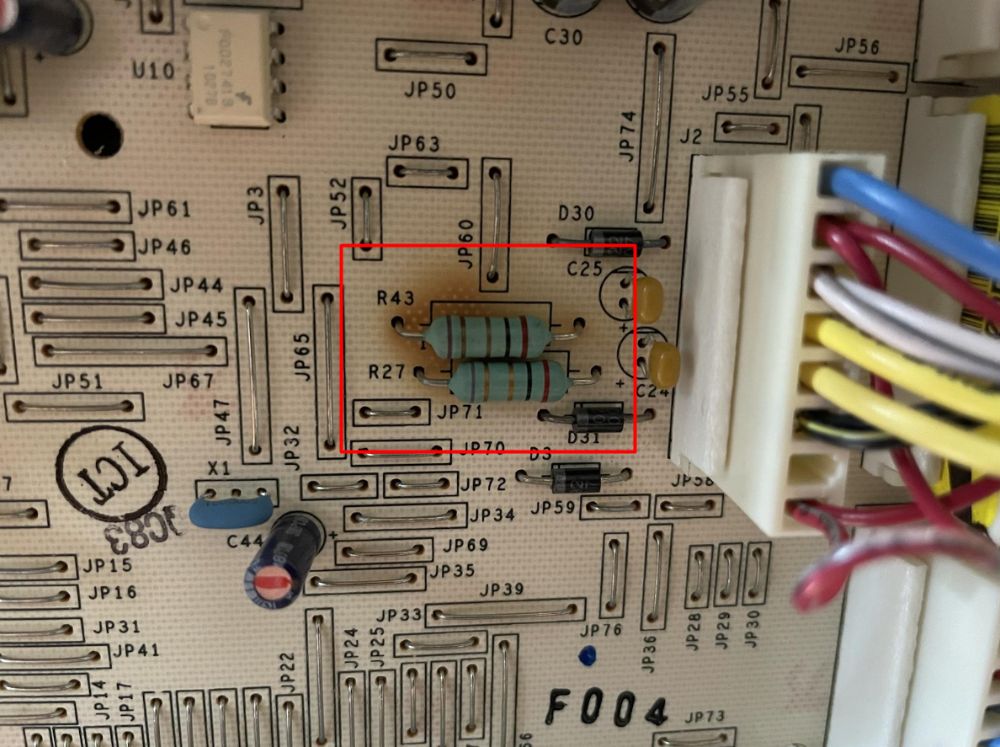
A quick tip: Some fridge models, like the LG Inverter Linear Compressor Refrigerator, boast a dedicated reset button on the motherboard. A simple press might just breathe life back into your fridge.
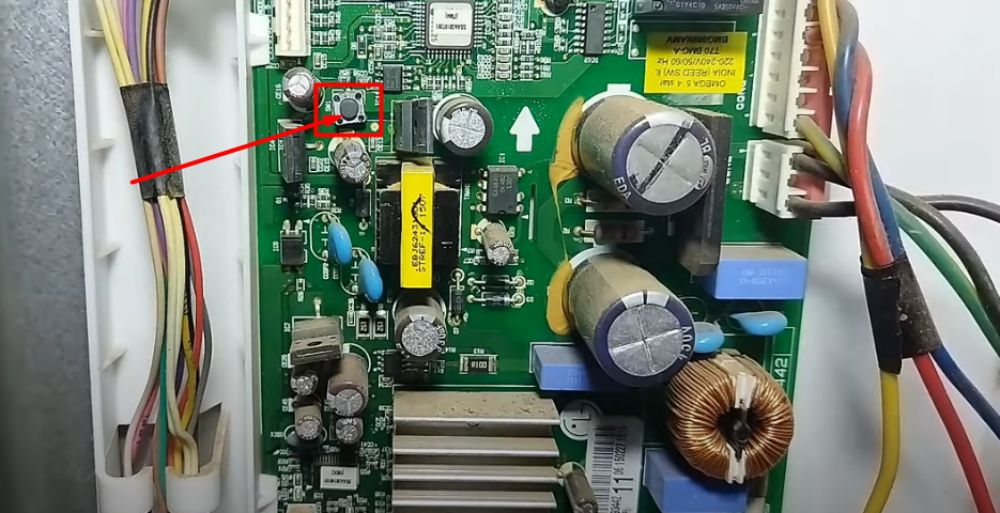
Sometimes:
Appearances can be deceiving. A control board may look pristine but be faulty. To be absolutely certain, you’ll need to put it to the test with a multimeter.
Granted, it’s a bit intricate, but manageable.
Check out this YouTube Video demonstrating how to test a GE fridge control board
Case in point:
If you have a GE 2019 Profile PVD28BYNFS or PVD28BYNBFS refrigerator, measure the voltage across these pins.
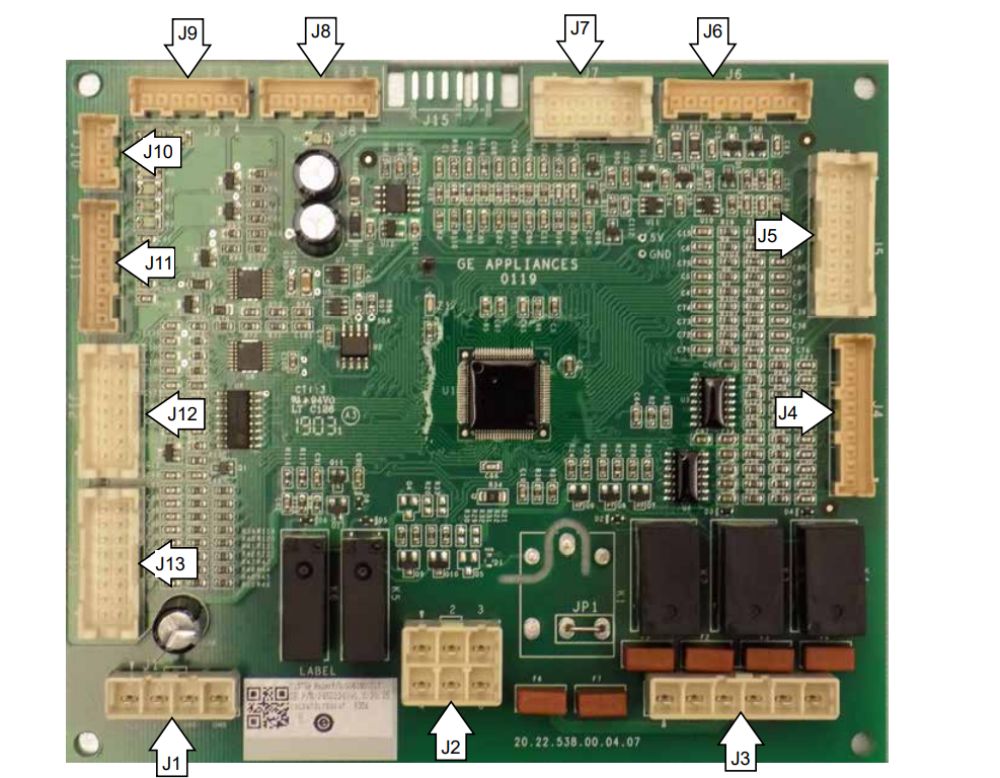
- J2 pin 2 to J2 pin 6: 120 VAC
- J1 pin 1 to J1 pin 3: 12.5 VDC
- J1 pin 2 to J1 pin 4: 12.5 VDC
- J1 pin 2 to J6 pin 9: 12.5 VDC
- J6 pin 3 to J6 pin 4: 12.5 VDC
- J6 pin 3 to J6 pin 9: 12.5 VDC
If the figures don’t match, then the control board is faulty.
Note:
This procedure and benchmarks are usually detailed in your fridge’s technical service guide. If you cannot locate yours, search for it online or ask for help in our Facebook group.
Solution:
If the control board is faulty, It’s time for a swap.
Here, you have two options:
Buying a new board or a used one from online marketplaces such as eBay and Facebook Marketplace
Note:
As David states, “Some motherboard issues are repairable. A quick online search can link you up with a skilled repair technician nearby.”
Finally:
Before you shell out your hard-earned cash, double-check your warranty. Depending on your fridge’s brand and model, the main control board might be covered.
For instance, some GE fridges boast a 5-year parts-only warranty. If you’re in luck, get in touch with your brand.
3. Compressor or Start Relay
| Part | Compressor | Start Relay |
|---|---|---|
| Location | Bottom area. Usually accessed from the back. | Bottom area. Usually connected to the compressor. Note: The compressor start kit comprises a start relay, capacitor, and overload protector. |
| Ease of troubleshooting | Hard | Easy |
| Replacement cost | $150-$700 | $20-$100 |
| Repairable | No | No |
| Note | The compressor is part of the sealed system. | Some fridge models don’t have a start relay. Instead, they have an inverter board. |
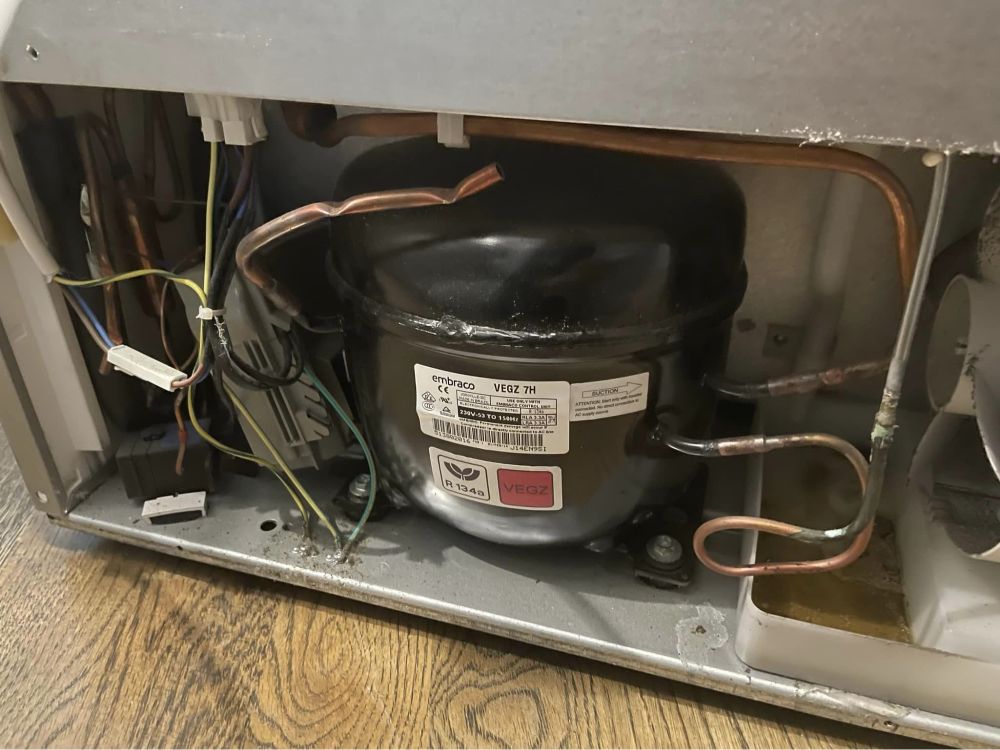
Problem:
The compressor, along with its trusty sidekick, the start relay, is another duo that is particularly susceptible to damage from power surges.
If either of these key components is compromised, your fridge won’t cool.
As David explains: “The compressor is the “heart” of a refrigerator. It’s responsible for pumping refrigerant through the system, removing heat from the fridge and freezer areas.”
But what about the start relay?
“When it’s time for the compressor to spring into action, the start relay offers the essential jump-start. Once the compressor is running, the relay switches off,” David adds.
Where can you find these two?
In most refrigerators, the compressor and start relay are located at the bottom back of the fridge. The start relay is usually attached directly to the compressor.
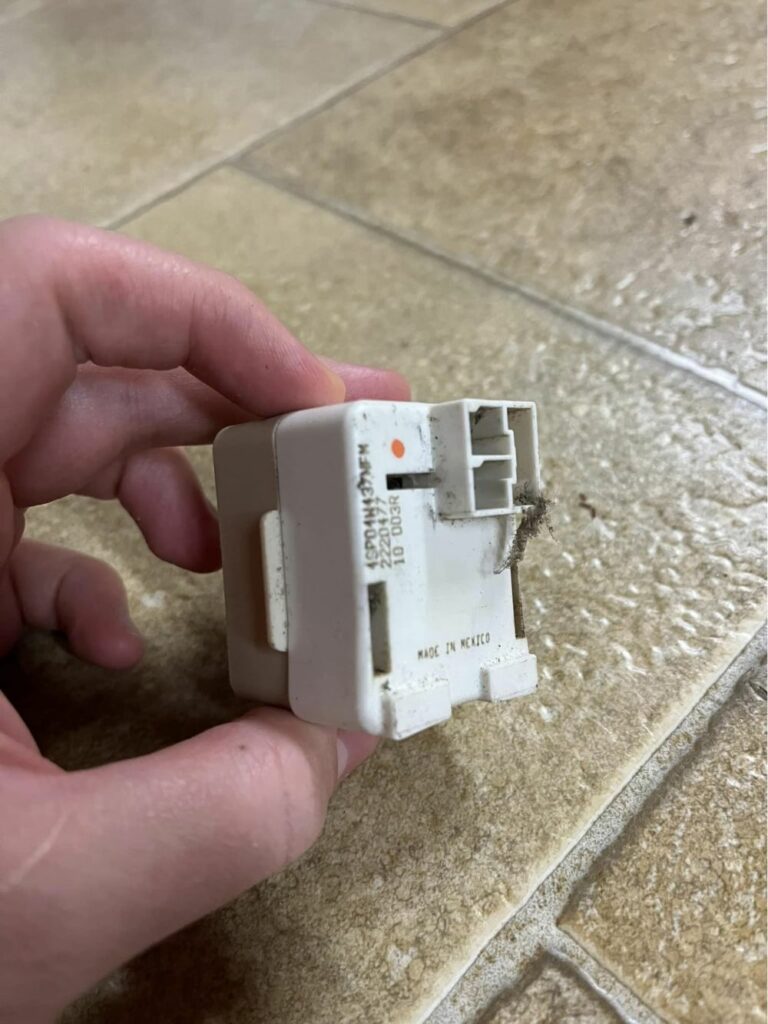
Identification:
Here is how to inspect and test the compressor and the start relay.
- Step 1: Power test
Check if the compressor has power.
A quick trick?
Check if the condenser fan is running. If it is, the compressor has power, as they’re on the same circuit.
But for a foolproof test, disconnect the power supply cables and measure the voltage.
- Step 2: Testing the start relay
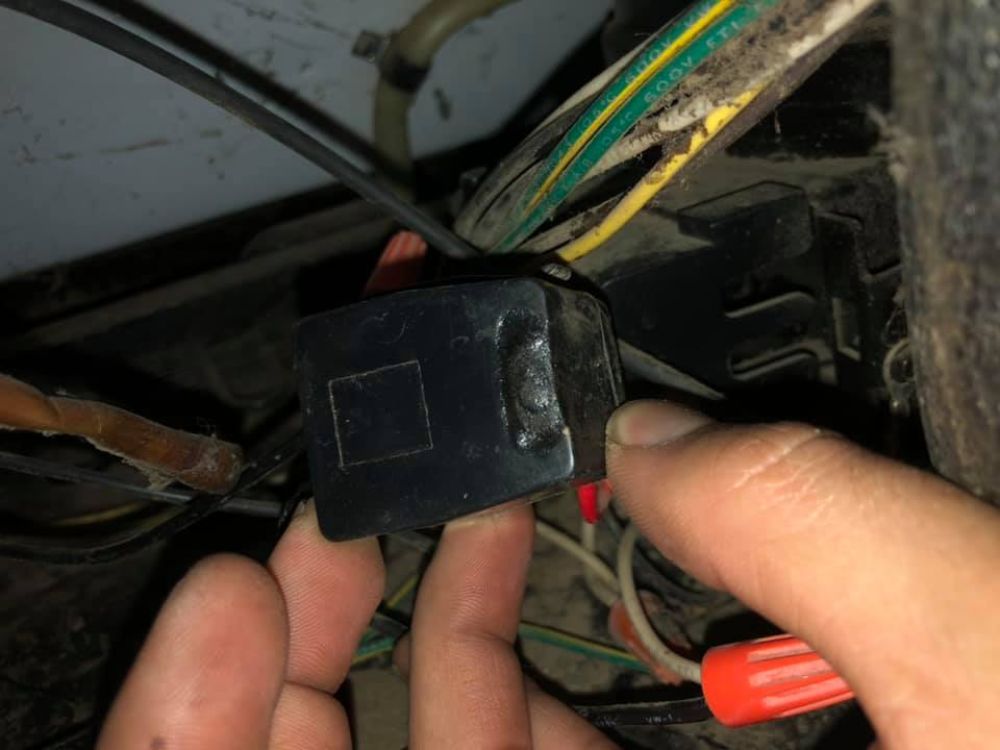
First:
Detach the start relay from the compressor and inspect it for damaged wires or burned sections.
Note:
“Disconnecting the start relay from the compressor reveals the three pins that you will use to test it,” David shares.
Next:
Shake the start relay gently. If there is rattling, It’s probably damaged.
- Step 3: The compressor check
Lay your hand gently on the compressor. Here’s what to note:
- If it’s buzzing with a slight vibration and feels a touch warm, it’s operating.
- Overheating? It might be failing.
- Buzzing but no cooling? It might have taken a hit.
- All quiet? Power might not be reaching it.
“If there is no power to the compressor, the control board, start relay, or inverter board could be the culprits,” David says.
- Step 4: The compressor test
As David advises: “To test the compressor, use a multimeter to measure resistance across its three terminals, as illustrated in this video.”
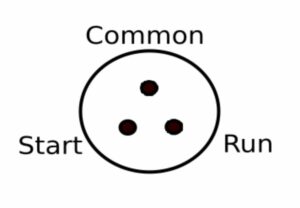
For a healthy compressor, you should get readings in the following range.
- Common pin to Start pin – 3-11 ohms
- Common pin to Run pin – 1-5 ohms
- Every pin – ground – Open
Quick Tip from David: “If you have an Inverter compressor, it should display a reading of between 6.1-11 ohms when measuring any two pins.”
Solution:
If your compressor is faulty, replacement is the only option; they’re not designed for repairs.
However, they are quite expensive. So, if it’s costing you more than 20% of the fridge’s value, investing in a new fridge might be the smart option.
On the other hand, if the culprit is the start relay, you are in luck since they are usually cheap and easy to replace.
Remember:
Some fridges have variable-speed compressors that employ an inverter board instead of a start relay.
If you’re missing the relay, scrutinize the inverter board instead.
Finally:
Many fridge brands offer a warranty covering the compressor. Always cross-check your warranty specifics.
Below are some fridge brands and their compressor warranties.
| Brand | Warranty |
|---|---|
| KitchenAid | Some models have 5 years (full), 10 years (parts only) |
| Miele | Some models have 5 years (full), 10 years (parts only) |
| LG | Some models have 5 years (parts), 5 years (labor) |
| Samsung | Some models have 10 years (parts), 5 years (labor). |
| Maytag | Some models have a 10-year warranty. |
| Whirlpool | Some models have a 5-year warranty. |
| Kenmore | Some models have a 5-year warranty. |
4. Inverter Board
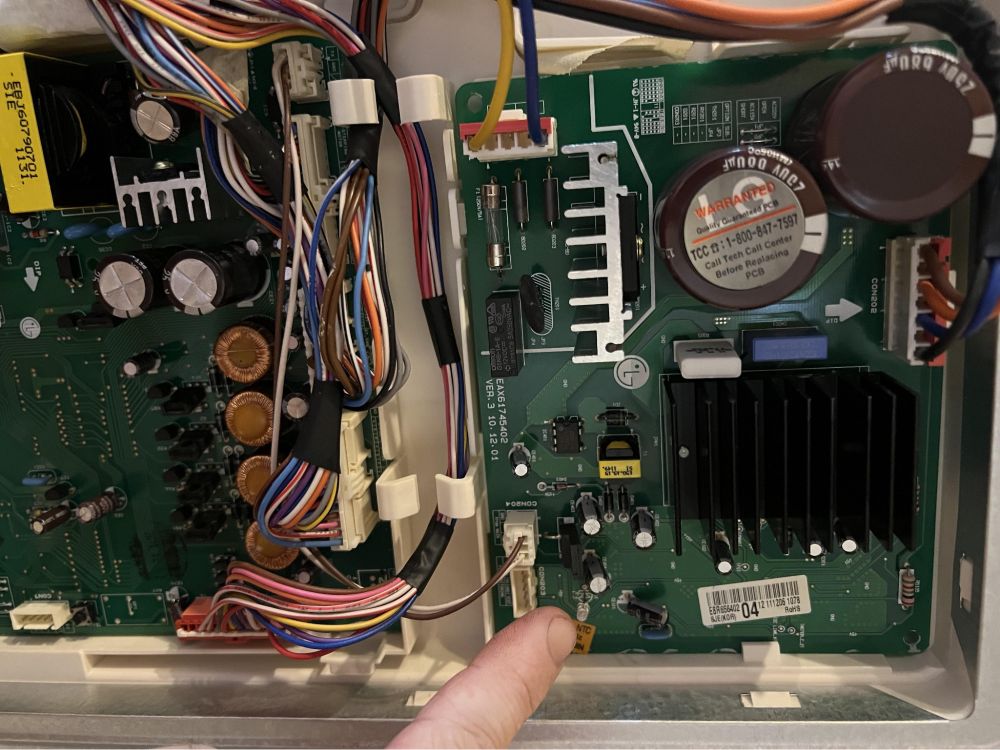
| Part | Inverter board |
| Location | Near the compressor Next to the main control board |
| Ease of troubleshooting | Hard |
| Replacement cost | $100-$600 |
| Repairable | Some issues are repairable. |
Problem:
Now:
If you have an inverter fridge, its design differs a little bit from the traditional fridge.
As David explains: “Instead of a standard compressor and a start relay, inverter fridges utilize a digital inverter compressor and an inverter board.”
Typically:
You’ll find this board positioned close to the compressor or adjacent to the main control board.
Now:
“Much like its counterpart, the main control board, the inverter board is vulnerable to the wrath of power surges,” David expounds.
Identification:
Here is how to inspect and test the inverter board.
- Step 1: Condenser fan check
Start by observing if the condenser fan is running. A working fan generally means the compressor is powered up because of their shared circuitry.
- Step 2: Compressor Check
Feel the compressor for warmth and vibration. If it’s active, the issue isn’t with the inverter board.
If the compressor isn’t running, the inverter board can be the cause.
- Step 3: Board checks
Inspect the inverter board closely for noticeable damage, such as burn marks or deformed components.
- Step 4: Multimeter test
Use a multimeter to test the board, as shown in this video.
Solution:
According to David: “Should your investigation pinpoint a malfunctioning compressor inverter control board, it’s time for a replacement.”
You can buy a new or used one from online marketplaces such as eBay and Facebook Marketplace.
5. The Fridge Needs a Reset
Now:
Sometimes, the reason your fridge isn’t starting after a power outage is what I refer to as a temporary freeze.
First: Patience
If the compressor is running, let the fridge rest for some time.
As this Redditor hilariously puts it: “If your fridge won’t start, try threatening it and giving up on it. After about 4 hours, our fridge sorted its shit out and started working again on its own.”
David echoes the same sentiment: “I’ve encountered fridges that appeared lifeless but suddenly sprang back to life as if nothing happened after a few days.”
There are two possibilities here:
Either the fridges were stuck or they needed time to recalibrate and stabilize the temperatures.
Secondly: Restart the fridge
Unplugging the fridge and waiting for up to 30 minutes before plugging it back in may do the trick.
“One of my latest repairs was for a Samsung fridge that would not start automatically after a power outage. You had to unplug and plug it back in for it to work,” David shares.
Thirdly: Reset the fridge
A member of our Facebook group shared that she uses the default setting button on her Frigidaire Gallery JBND-28 Refrigerator when it fails to start after a power outage.
This user used the reset button inside his fridge to reset his GE washer that couldn’t start after a power outage.
That’s not all:
There is also this user who fixed this issue on their Samsung fridge by pressing the Energy Saving and Lightning buttons simultaneously for 8 seconds.
So:
Check out how to reset your fridge and see if that will do the trick.
How To Protect Your Fridge Damage After a Power Outage
1. Use a Surge Protector
When power returns after an outage, it can come with surges that can damage electronic components. A surge protector can prevent these sudden spikes in voltage from reaching your fridge.
2. Unplug the Fridge
If you are at home, unplug the fridge from the power outlet immediately after the outage. When power is restored, wait for a few minutes (5–10 minutes) to ensure stable power without surges.
Conclusion
In a Nutshell…
Power outages can be a sneaky nemesis for a plugged fridge. When they strike, they sometimes leave behind a trail of chaos.
The most affected components include:
- Main control board (motherboard)
- Compressor
- Start relay
- Inverter board
Sometimes, the fridge could be stuck. In such a case, a quick unplug and reset might be all it needs. Other times, it may be taking time to stabilize the temperatures. So, give it time.
If you are unable to find the cause, consult a professional repair tech. You can also ask for help in our vibrant Facebook group.

